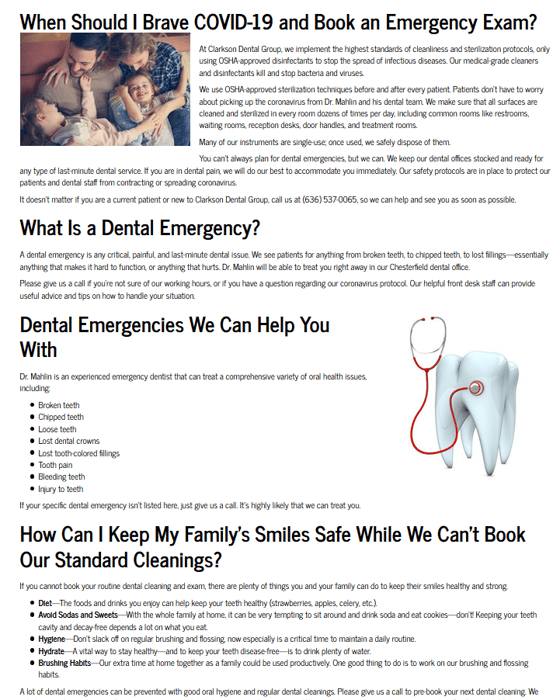Share this
COVID-19: Marketing Emergency Dental Services
by Jeff Gladnick on Nov 4, 2020 10:00:00 PM
A few days ago, the ADA published guidance found HERE around what constitutes dental emergencies that should still be performed by dental practices across the country, and what should be deferred until after the Coronavirus Pandemic has passed.
Additionally, today Oregon issued an executive order found HERE effectively closing dental practices till June 15 - although that will surely be updated and reduced if conditions allow. For states and jurisdictions where dentistry is still allowed to be practiced, each dentist will have to make their own decisions about what is safest for them and their patients.
But assuming you are under “emergency only” dentistry mode, what can be done and how can this be marketed to your patients - if at all? For those of you who feel that no dentistry should be done under any circumstances - consider the alternative for a patient suffering dental trauma - ending up in the ER. Physicians in the ER need beds to treat life threatening cases and mitigate the COVID-19 Pandemic. Treating an emergency in your practice that would have otherwise gone to the ER relieves the pressure a bit.
So what are the emergency cases you should be treating?
According to the ADA:
Examples of urgent dental care treatments, which should be treated as minimally invasively as possible, include:
- Severe dental pain from pulpal inflammation.
- Pericoronitis or third-molar pain.
- Surgical postoperative osteitis or dry socket dressing changes.
- Abscess or localized bacterial infection resulting in localized pain and swelling.
- Tooth fracture resulting in pain or causing soft tissue trauma.
- Dental trauma with avulsion/luxation.
- Dental treatment cementation if the temporary restoration is lost, broken or causing gingival irritation.
Other emergency dental care includes extensive caries or defective restorations causing pain; suture removal; denture adjustments on radiation/oncology patients; denture adjustments or repairs when function impeded; replacing temporary filling on endo access openings in patients experiencing pain; and snipping or adjustments of an orthodontic wire or appliances piercing or ulcerating the oral mucosa.
How to communicate this to your patients:
First, put a notification on your website, preferably near the top of your website, like this:

Better yet, add a link to your emergency services page like this:


Marketing Emergency Services
If you are willing and able to spend marketing dollars at this time, Google/PPC ads and Social Media ads are a good avenue to reach patients who are in need of the aforementioned emergency services. SEO techniques work well, but do take longer than PPC ads, which can be turned on instantly. Both of these avenues should be considered as part of your strategy to reach patients who are in urgent need of emergency dental services.
We know that it's hard for all practices right now. We're here to help, and if you need to talk about options, get advice or feedback on what you're doing, or just need to chat about ideas, shoot me a message at jeff@greatdentalwebsites.com and I'll respond to you personally. We've built our company on our relationships with our clients, and we want to continue that regardless of your services, providers, etc.
-Jeff Gladnick
Share this
- November 2024 (1)
- October 2024 (4)
- February 2024 (1)
- January 2024 (2)
- December 2023 (1)
- November 2023 (1)
- October 2023 (1)
- September 2023 (2)
- August 2023 (4)
- July 2023 (3)
- June 2023 (2)
- May 2023 (1)
- April 2023 (3)
- March 2023 (2)
- February 2023 (2)
- January 2023 (3)
- December 2022 (2)
- October 2022 (3)
- September 2022 (2)
- August 2022 (2)
- July 2022 (1)
- June 2022 (1)
- May 2022 (1)
- April 2022 (5)
- March 2022 (4)
- February 2022 (20)
- January 2022 (14)
- December 2021 (1)
- November 2021 (4)
- October 2021 (1)
- September 2021 (2)
- August 2021 (12)
- July 2021 (40)
- June 2021 (2)
- May 2021 (5)
- April 2021 (7)
- March 2021 (4)
- February 2021 (13)
- January 2021 (5)
- December 2020 (3)
- November 2020 (24)
- October 2020 (37)

